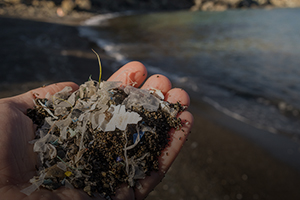Eliminating Microplastic Waste

Research has confirmed that tiny fragments of plastic debris have made their way into every corner of our environment. They’re in our oceans, our soil, our food, and even the air we breathe. Known as microplastics, these miniscule particles contain trace metals and chemicals that can leach out with potential toxic effects.
One approach to cleaning them up is by using microrobots — devices the size of a bacterium that attach themselves to microplastics and begin breaking them down. The tiny metallic robots are shaped like a four-pointed star and coated with magnetic particles. When placed in water along with a small amount of hydrogen peroxide and exposed to light, they can move through the water adhering to the plastics, while charged molecules produced through photocatalysis break down the chemical bonds. The microrobots can then be collected using a magnet.
Further testing is needed to determine whether the bots are safe for long-term use, and to study what other substances might be affected by them. Until then, the most effective way to reduce microplastics in the environment is to stop them fro.0m getting there in the first place by reducing our use of plastics, synthetic fabrics, and other petrochemical materials.
For information: Martin Pumera, University of Chemistry and Technology, Nanorobots Research Center, Technicka 5, 160 00 Prague 6 – Dejvice, Czechoslovakia; Web site: https://www.vscht.cz/home or https://www.nanorobots.cz/#home